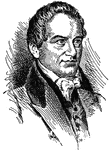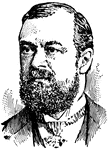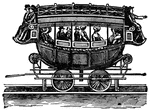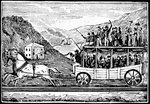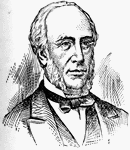
George Brown
(1787-1859) Railroad promoter who gave generously to the House of Refuge and the Peabody Institute of…
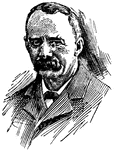
Edward Henry Harriman
(1848-1909) Financier and railroad executive who lead an expedition to Alaska. He published a 2-volume…
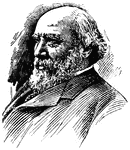
James Jerome Hill
(1838-1916) Railroad executive and financier that was known as "Hill the empire builder" because of…

The Sixth regiment
Thousands of patriotic citizens filled every available space in the big railroad station in Jersey City…

Camp Lillie
Headquarters of General Freemont, Jefferson City, Missouri, October 1, 1861. Jefferson City is on the…
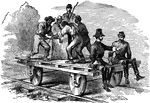
General Burnside
"Traveling in state"- General Burnside on the road from New Berne to Beaufort, N. C.

Valley of Chickahominy
"Valley of the Chickahominy, looking southeast from the vicinity of Mechanicsville, the scene of the…

Camp Dennison
"Camp Dennison, sixteen miles above Cincinnati, on the banks of the Miami River, General Cox commanding-…

View of Grafton
"View of Grafton, West Virginia, occupied by the Federal Troops, under the command of General McClellan,…

Bouquet Battery
"The Bouquet Battery, commanding the viaduct over the Patapsco River, on the Baltimore and Ohio Railroad,…

Rappahannock Bridge
"Rebuilding of the railroad bridge over the Rappahannock to Fredericksburg, burnt by the Confederates…

Creek Railroad Bridge
"Burning of the gunpowder Creek Railroad Bridge, on the Philadelphia and Baltimore Railroad, by the…

Battle of Savages Station
"Battle of Savages Station. Brigadier General Smith's division hotly engaged with the enemy, at noon,…

Bellaire, Ohio
"Bellaire, O.- Steamboats conveying troops and munitions of war for the Federal forces on the Great…

Kentucky Raid Rally
"The Confederate raid into Kentucky--excitement at Convington--gathering of armed Federal citizens at…

Landing at Parkersburg
"Landing of Federal troops at Parkersburg, Western Virginia. Parkersburg, Va., in 1861 was a thriving…

Rolla Camp
"Encampment of the Federal army near Rolla, Mo. The city of Rolla has been famous since the death of…

Village of Clarksburg
"Village of Clarksburg, Western Virginia, headquarters of General Rosecrans. Clarksburg, a post village,…

View of Strasburg
"View of the town of Strasburg, valley of the Shenandoah, occupied by the Federal forces under General…

Jefferson City, Missouri
"Jefferson City, capital of Missouri. The arrival of General Fremont's division, September 26th, 1861.…

Fort Thompson
"Bombardment and capture of Fort Thompson, thirteen guns, near New Berne, on the Neuse River, by the…

Pocotaligo Bridge
"The Federal troops under Generals Brannan and Terry driving the Confederates under beauregard across…

Paducah, Kentucky
"View of the town of Paducah, Ky., at the confluence of the rivers Ohio and Tennessee, the Northern…

Thoroughfare Gap
"Thoroughfare Gap, Va., a pass in the mountains on the Manassas Gap Railroad, near Strasburg, held by…

Campaign in Kentucky
"The campaign in Kentucky, Federal troops under General Johnston, advancing on the Louisville and Nashville…
Fort Clinch
"Exterior view of Fort Clinch, on Amelia Island, Fla., commanding the Harbor of Fernandina, captured…

Grand Skedaddle
"The 'Grand Skedaddle' of the inhabitants from Charleston, S. C., when threatened by an attack from…
Commissariat Depot
"Commissariat Depot of the United States Army of the Rappahannock at Manassas, Va. Our sketch shows…
Falmouth
"The town of Falmouth, Va. on the Rappahannock, opposite Fredericksburg. Headquarters of General Burnside…

War in Virginia
"The war in Virginia- officers and men of Meade's army discovering unburied Federal dead on the old…
Ogeechee River
"Reconnoissance in the great Ogeechee River, near Ossabaw Sound, Ga., by the ironclad monitor Montauk,…
Culpepper Courthouse
"Culpepper Courthouse, or Fairfax, capital of Culpepper County, Va. This pretty little place, more frequently…

Loudon Heights
"View from Loudon Heights, Va., showing Harper's Ferry, Maryland Heights, Bolivar, etc. Harper's Ferry,…

General Rufus King
"General King, born in New York city, January 26th, 1814, died there, October 13th, 1876, was graduated…

Cumberland Army
"The army of the Cumberland- Wilder's mounted infantry passing a blockhouse on the Nashville and Chattanooga…

Entering Clinton
"General McPherson entering Clinton, Miss. To facilitate the movements of the Federal armies near Chattanooga…

War in Georgia
"The war in Georgia- Stevenson, Ala., depot for General Rosecrans's Army. The campaign of General Rosecrans…

Sherman's Campaign
"Sherman's Campaign in Georgia- the attack of the Fourteenth, Sixteenth and Twentieth Army Corps on…

Battle of Ream's Station
"The Siege of Petersburg. Battle of Ream's Station- the attempt of the enemy to regain the Weldon Railroad…

Belle Isle
"View of Richmond, Va., from the prison camp at Belle Isle, James River. Belle Island is situated in…

Macon Railroad
"Sherman's campaign in Georgia- Federal forces at Jonesborough destroying the Macon Railraod."— Frank…

War in Georgia
"The war in Georgia. Wagon train passing Resaca at night. Our correspondent wrote: 'No general probably…

War in Virginia
"The war in Virginia--railroad bridge over the Rappahannock, at Rappahannock Station."— Frank Leslie,…

Manassas
"The war in Virginia--General Hooker's army marching past Manassas, Va., June, 1863."— Frank Leslie,…

Sixteenth Regiment
"The Sixteenth Regiment, Ohio Volunteers, under Colonel Irwine, crossing the tray run viaduct, near…

Front Royal
"Front Royal, Manassas Gap Railroad, Blue Ridge Mountains in the distance- the Federal army entering…
Railroad Trail
"Trail between Peter Cooper's locomotive Tom Thumb and one of Stockton's and Stokes' horse…

Railroad Ticket
"Obverse and Reverse of a ticket used in 1838 on the New York and Harlem Railroad."—E. Benjamin Andrews,…

Union Pacific
"The big loop on the Georgetown branch of the Union Pacific, Colorado."—E. Benjamin Andrews 1895
